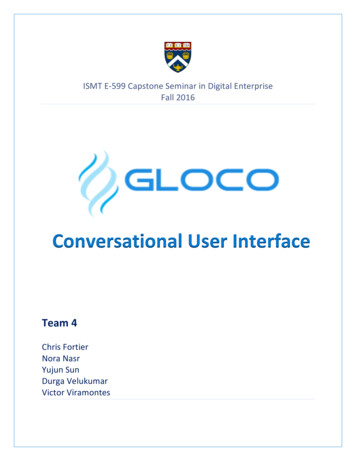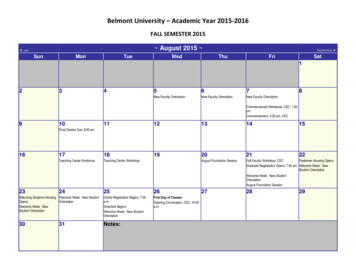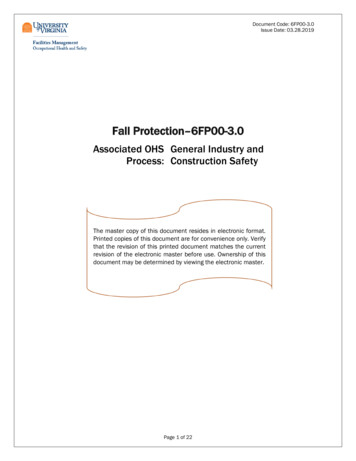
Transcription
ISMT E-599 Capstone Seminar in Digital EnterpriseFall 2016Conversational User InterfaceTeam 4Chris FortierNora NasrYujun SunDurga VelukumarVictor Viramontes
Table of Contents1.Executive Summary . 31.1GLOCO . 31.2ICT . 31.3The Solution . 32.Business Requirements . 42.1Business Summary . 42.2Business Problem . 62.3Business Objectives. 62.4Business Epic and User Stories . 62.5Required Functionality . 82.6Success Metrics . 82.7Business Benefits Justification . 93.Technical Specifications . 103.1Architectural Approach. 103.2Software Solution . 123.3Integration with Applications and Data Sources . 173.4Data Design & Management . 193.5Solution Demonstration . 214.Implementation Plan . 234.1Solution Delivery Roadmap . 234.2Operationalization. 264.3User Enablement . 284.4Success Metrics . 302
1. Executive Summary1.1 GLOCOGLOCO is a multinational medical equipment manufacturing company providing its products toclients around the globe. The company recorded net revenue of 7 billion dollars last year,making it one of the largest medical equipment manufacturers in the world today.Currently, end customers interact with GLOCO systems using the GLOCO Consolidated Gatewaythat sits between users and business unit sub-systems such as product information pages, theCRM system, and order tracking tools. GLOCO’s vision is to enhance usability for all endcustomers of its systems.1.2 ICTWe as GLOCO’s ICT (Information Technology and Communications) organization propose a newConversational User Interface (CUI) system to empower end customers and facilitate thepenetration of the end customer market segment. The system will have two broad interfaces: achatbot style text interface as well as a voice recognition system. Both of these systems willfeed the requests to a natural language processing (NLP) system for analysis. This system willinteract with the GLOCO Consolidated Gateway API to reach each of the business unit subsystems.The CUI enabled application will significantly reduce complexity for end customers as they willhave a single point of access. This in turn reduces the complexity of managing customerinteraction for the staff. Overall cost of managing the different systems will also be reduced asthere will be less reliance on service desk staff and more automation of customer requests. Thisallows IT processes to be more agile and improves service time.The CUI interface will be integrated as an enhancement to the existing web and mobileapplications. GLOCO ICT will integrate best of breed third-party technology to provide the CUI.1.3 The SolutionWe propose to develop a solution that provides the following high-level capabilities: A speech and chatbot enabled natural language interfaceIntegration with GLOCO Consolidated Gateway API3
Ability to select products, place orders, and track shipments Collects and tracks customer usage trends and behavior Allows fast service support through the application chat functionality Notifies customers of new products and services from GLOCO Enables customers to receive alerts from their medical equipment. For example, a pumpfeeder can send alerts if the feeding formula has finished or if there is an error, directly tothe registered user’s mobile applicationThe GLOCO CUI tool will improve the customer experience, reduce costs and maintain thecompany’s competitive advantage.2. Business Requirements2.1 Business SummaryFigure 1: GLOCO As-Is Diagram4
The current As-Is interaction with GLOCO systems for end customers requires many steps and ahigh-level of user sophistication. All interaction requires that inputs be typed, whether using aphysical keyboard and mouse or mobile touch input.There are several steps involved that require users to directly interact with many systems inturn, in the proper order. Figure 1 shows the example of order placement. A user would haveto first access GLOCO’s main website, GLOCO.com. Then, navigate to products and make aselection. From there, the user would then need to go to order processing to initiate apurchase order. And from there, to shipping to input shipping address information. Next,billing would have to be contacted to accept credit card information. Finally, checkout wouldbe initiated by the customer. And once it succeeds, the order confirmation would be received.There are many steps and therefore many chances that the customer will fail to order or simplylose interest.Figure 2: GLOCO CUI To-Be DiagramThe proposed To-Be process is much simpler from the customer perspective, but is onlypossible thanks to the use of the latest developments in Machine Learning (ML) and Big Data.Figure 2 shows an example of a reorder of medical equipment. Our new CUI would allow endcustomers to simply start the GLOCO mobile phone, select the CUI, and start talking. Thecustomer would only need to request a reorder and then the mobile app would confirm theorder and initiate the reorder using the data already stored by GLOCO about the customer. Thesimple interaction ensures all customers are able to make the orders they need.5
2.2 Business ProblemGLOCO conducted a survey to gauge convenience and usability among individual customers.Based on the survey results and other data, this section describes some of the issues thatGLOCO is currently facing and why GLOCO is losing its competitive edge: Existing mobile and web apps are difficult to use for customers over 65 (this represents45% GLOCO’s customer base) People will accessibility needs are having difficulty navigating the GLOCO website Conversion rates are low, mobile app telemetry showed that 65% of consumers are placingitems in the shopping cart but not completing the purchasing transaction Data correlation shows that 30% of incomplete transactions were later completed by adirect phone order required support staff The remaining 35% of incomplete transactions were never completed Monitoring of medical equipment is a challenge for consumers.2.3 Business ObjectivesThese are the following objectives for GLOCO CUI: Increase customer satisfaction when dealing with GLOCO web and mobile applications. Drive consumers from all market segments (including elderly and disabled consumers) touse the mobile and web application capabilities.Gain competitive advantage over close competitors. Make tools easier to use for customers. Reduce requests for customer service support. Increase online sales through the mobile app with verbal requests.2.4 Business Epic and User StoriesBusiness EpicAdd a Conversational User Interface (CUI) to GLOCO web and mobile apps.User Story 1As a consumer, I want to be able to verbally ask the GLOCO application about whether specificmedical equipment is available and what is the equipment features and price. I want theGLOCO app to provide this information to me orally and without having to navigate theapplication.6
Acceptance Criteria:The application shall translate the consumer’s verbal request to commands and interface withthe GLOCO consolidated API gateway which will query the supply chain management system,and provide information on products, description, and prices verbally and visually.User Story 2As a consumer I want to use voice to be able to complete a purchase online verbally, withoutnavigating the application or calling the service desk.Acceptance Criteria:The app shall translate the consumer’s verbal request to commands and interface with theGLOCO consolidated API gateway which will in turn place an order through the CRM and ERPsystems. The GLOCO app will orally confirm the receipt of the order and expected delivery date.User Story 3As a product manager, I want all customer segments (including elderly and disabled people) tobe able to verbally complete their entire purchasing transactions.Acceptance Criteria:The app shall become intuitive and be able to translate the consumer’s verbal request tocommands and interface with the GLOCO consolidated API gateway to pass on the instructionsto the concerned enterprise system. It will provide a clear verbal response to the consumer'soral queries and instructions.User Story 4As a consumer, I want to be able to verbally ask GLOCO app about the status of devices that Ihave purchased and are currently installed in my home. I also want the app to orally respond tomy queries and verbally alert me when one of my devices is not functioning properly.Acceptance Criteria:The app shall translate the customer’s verbal request and interface with the API gateway whichwill in turn query the data from the IoT system, retrieve the data, and present the informationto the user vocally. Once an alert is received from the medical equipment, the app will verballyannounce that there is a device error.7
2.5 Required FunctionalityBelow is a list of the functional and non-functional requirements.Note that GLOCO does not collect medical information around any of its equipment users, andtherefore the company is not subject to HIPPA audits. The existing web and mobile applicationfulfills the PCI DSS requirements for online credit card purchasing.Functional Requirements Ability to process spoken natural language and translate it to text. Ability to process textual natural language into GLOCO Consolidated Gateway API calls. Enable product purchases via voice.Enable product availability and price queries via voice. Provide new CUI option in existing GLOCO mobile applications. Enable instrumentation to record the usage of CUI through the use of telemetry. Provide new dashboards and reports of CUI usage for existing GLOCO enterprise portal. Ability to receive responses from the GLOCO consolidated API and forward those to usersin text and verbal format.Nonfunctional Requirements Improve usability of GLOCO mobile app. Provide easy-to-follow verbal cues and responses. Provide users with a variety of pleasant voices to converse with to enhance usability. Provide intuitive online support. Ensure app and data collected are secure.2.6 Success MetricsA list of metrics was created according to each of the Business goals in measuring howsuccessful this project would be. According to figure 3, fifteen percent of increase in netpromoter score is expected as we say that we successfully increased customer satisfaction byimplementing CUI for GLOCO. Additionally, 20 percent increase in app traffic and customersatisfaction survey score, 15 percent increase in market share, 10 percent reduction in laborcost, and 30 percent increase in conversion rate are also expected relative to measure thesuccess of each business goals.The numbers in this list of success metrics are generated by several prediction methodsincluding but not limited to the business analysis report, marketing report, and financial8
predicting models. However, these numbers can still be shaped by later process of this project.Thus, we will keep these predictions at this point, and will come back to make anymodifications or adjustments later if needed.Business GoalSuccess MetricIncrease customer satisfaction when dealing with GLOCODrive consumers from all market segments (including elderlyand disabled consumers) to use the mobile and webapplication capabilitiesGain competitive advantage over close competitorsIncrease net promoter score by 15%Increase app traffic by 20%Make tools easier to use for customersIncrease customer satisfaction survey scoresby 20%Reduce cost for customer service staff by 10%Increase conversion rate for app sales by 30%Reduce requests for customer service supportIncrease online sales through the mobile app with verbalrequestsIncrease market share by 15%Table 1: Table of Success Metrics2.7 Business Benefits JustificationAs we mentioned before, GLOCO has decided to outsource the technical part of this project to athird party vendor. The CIO has assigned a budget of 5 million dollars for this project. Inaddition to that, an additional budget of 1 million dollars is estimated for annual maintenancecost after the initial implementation.Return on investment (ROI) is associated with the success metrics. We have divided returns intotwo categories, tangible and intangible benefits. Tangible benefits could be evaluated bynumbers directly. For instance, we estimated an increase of 10 percent in net sale per year dueto increased market share. Intangible benefits could not be reflected directly by numbers, butthey play a key role in establishing long term competitive advantages.Cost of Implementing CUI Estimated implementation cost: 5 Million ( 7% of total revenue) Estimated maintenance cost: 1 Million per yearROI and Tangible Benefits Estimated increase in net sale of 10% per year Reduce labor cost of customer service by 10%9
ROI and Intangible Benefits Estimated increase of 10% of customer population next year Retain competitive advantage in market Increase in customer satisfaction rating3. Technical Specifications3.1 Architectural ApproachThe GLOCO CUI, built using the API.AI technology, adds the conversational functionality as anenhancement to GLOCO’s existing website and mobile applications.3.1.1 Architecture Components GLOCO website or mobile application on iOS and Android: These are equipped with theAPI.AI JavaScript SDK. This client side SDK handles audio recording and streaming on theuser’s device.Controller: The controller centrally manages the full interaction. It routes natural languageorder requests to and from the API.AI agent. The controller also manages the fulfillment oforder requests.API.AI Agent: does speech recognition and converts natural language into actionable data.It performs natural language understanding by matching the order text input to preexisting purchasing intents and domains (detailed in section 3.2.4). The agent also managesthe full conversation flow.CUI Request Database: Incoming natural language requests and outgoing fulfilled requestsare recorded in the CUI Request Database for analysis and visualization purposes.GLOCO API Gateway: The GLOCO API gateway interfaces with both the controller and the existingenterprise CRM and Finance systems in the backend. Enterprise CRM and Finance systems: These enterprise systems fulfill purchase order requests.The GLOCO mobile and web applications, API gateway and CRM and Financial enterprisesystems are pre-existing components. The Controller and the CUI Request Database will be builtby GLOCO and hosted on premise. The API.AI Agent is provided by a third party, API.AI, andhosted in a public cloud.10
Figure 3 - Architecture Diagram3.1.2 Diagram DescriptionThe order of operations illustrated in Figure 3 is described below:1. A user sends natural language text or sound file (wav) from the mobile application orwebsite to the control as POST (HTTP) requests.2. The controller records the incoming request in the CUI Request Database.3. The controller forwards the natural language text or sound file to the third-part API.AIagent.4. The API.AI Agent does speech recognition and converts the natural language to text. Then itperforms natural language understanding, and returns actionable JSON objects to thecontroller.5. The controller begins the fulfillment process. It sends the JSON objects using Python to theGLOCO API gateway, which in turn send the purchase request to the CRM system. The CRMsystem sends payment information to the financial system if needed.6. The CRM and financial enterprise systems return a response to the GLOCO API gatewaywhich provides it to the controller.11
7. The controller records the returned response in the CUI request database.8. The controller sends the response to the API.AI agent which converts it back to naturallanguage.9. API.AI agent sends the natural language response back to the controller.10. The controller sends the response to the user’s device in natural language format.3.2 Software Solution3.2.1 Solution Selection – API.AIAPI.AI, a natural language processing company acquired by Google, has become one of the keyplayers in CUI platform development field. This is attributed to its leading technology in deeplearning methods,GLOCO ICT chose API.AI because it has the following key advantages: Holds competitive advantage with its most advanced speech and intent recognition, dialogunderstanding and management technology. Supports 15 different languages including English, Chinese, and Spanish. Provides very simple design and integration process. Supports multiple systems and platforms with one single CUI. Requires minimal development cost. Has great potential for future development with Google’s support.3.2.2 API.AI Functional InfrastructureApi.ai CUI follows a 4-level workflow in building any human-level dialogs: Speech Recognition - transcribes voice into readable text with Automatic SpeechRecognition (ASR).Natural Language Understanding - interpret the meaning of transcribed text andunderstand the intent of user’s command.Fulfillment - deliver user requests to the CUI controller for further action to be processed,and receive information from the CUI controller. This is the step to turn conversation intoreal action.Conversational Management - supports back and forth dialogue and creates meaningfuldialogue.As illustrated in Figure 4 , any incoming request is processed following this diagram totranscribe input, understand user’s intent, retrieve useful information and create intelligent12
responses. This process is repeated for each incoming inquiry, and a human-level conversationcan be build.Figure 4: Api.ai Functional Infrastructure Diagram.3.2.3 CUI ControllerWhen we speak of the CUI it is really a system of several modularized components. The centralprocessor will be the CUI Controller, a component that we will develop in-house to connect allof the other components together. The CUI Controller is the central clearinghouse for alloperations.As it will primarily serve to connect a number of web based REST interfaces we felt it wasimportant to use a toolset that is efficient for web applications but one that is also notburdensome to manage. We have decided to build the CUI Controller as a Python applicationusing the Flask framework. Python was chosen for a number of reasons: It is a powerful language without a significant learning curve. The third-party processors that we are considering all support Python. Python is very extensible and has numerous libraries for connecting with various systemssuch as databases, HDFS, etc. It is one of the primary and preferred languages for Data Science applications.The general flow of processing will begin with users speaking into a mobile device. That devicewill forward a .wav file to the CUI Controller. The Controller will act as the intermediary13
between the user and API.AI. Once a user request is fully understood the CUI Controller willinteract with the GLOCO API Gateway for internal processing of the purchase request with theCRM and financial systems. It will then communicate to API.AI to get the user response and willforward the response to the user.Example flow of a request though the CUI Controller:Figure 5 - Request flow through the CUI controller3.2.4 API.AI Design Model Description and DiagramsAPI.AI provides its own console for GLOCO developers to design and integrate theconversational user interface according to business requirements.The creation of basic CUI function involves 3 parts: Agent - represents one conversational interface supporting one language. For a differentlanguage, a new agent is needed. Developer creates an Agent by assign a name, language,machine learning level and other parameters. GLOCO’s first API.AI Agent will be in English.14
Intents - describes user’s purpose by saying certain things. Intents are designed andmanually created by developers specifically according to the functional requirements ofeach business. Since each intent supports one functional requirement, there are usuallymultiple intents required for a comprehensive Agent. For example, we expect users toplace orders, check device status through the Agent, then ‘order’ and ‘check status’ will betwo of the intents to create.Entities - work as categories that can map and capture the meaning of natural languagephrases. Multiple parameters may be needed to fully describe an entity. Entities are alsomanually defined and created by developers according to business needs. For example, ifwe have entities ‘product name’, ‘user id’, ‘shipping’, the intent order might requireentity ‘product name’ and ‘shipping’ to fully describe it, whereas the intent check statusmight require ‘product name’ and ‘user id’ to obtain complete information.TrainingThe API.AI Agent adopts advanced deep learning technology, and thus the training process isone of the critical configuration steps for the agent to function efficiently. After all the intentsand entities are created by the GLOCO developers, several sample user statements areprovided to train the agent to detect the user’s purpose and context. The agent could be ableto automatically detect user’s intent and entities from what user said after training it. As adeliverable product, the expected functionality is as following: When the user sends a request in natural language, the agent is able to detect the intent,and call-up intent with JSON.When Intent is called, a list of corresponding entities linked with this intent are also calledup and checked one by one to see if the user provided related information. If information for any required entity (or parameter) was not provided, the agent asksfurther questions for the user to provide additional information. If all entities are fulfilled, the agent is ready to send intent and entity information to theCUI Controller for fulfillment of the request and it waits for a response to complete theaction.The training process is the key enabler for the Agent to achieve human level conversation withhigh level intelligence. By saying human level conversation, we will not limit users to follow apredefined sentence structure to communicate; instead, GLOCO Agent will be trained to beable to understand different form of human expression. With a comprehensive training for themachine learning process, by the time of actual product release and implementation, theGLOCO Agent will be able to detect and relate synonyms, understand different spoken language15
structure, thus understand user when they say the same meaning with different expression.Additionally, the Agent is intelligent enough to collect errors, learn from mistakes, improvefrom its learning algorithm, and never perform the same mistake again. Thus, with a continuouslearning process, our Agent will be able to meet user’s expectation and increase userexperience.Figure 4 demonstrates a basic view of the API.AI console and the training process. The agent isnamed ‘GLOCO English’, and the intent ‘intent order’ and a list of entities are created as well.The agent is learning to capture entity information from provided sentences.Figure 6: Api.ai console review3.2.5 System MetricsAPI.AI offers different pricing packages with different supporting metrics. In the earlyimplementation phase, we plan to use the standard version which provides the followingmetrics: 750,000 queries per yearUnlimited private agents and pre-built domainsCustom models available for speech recognition (significantly increase accuracy)Guaranteed to meet SLADue to the large size of our company and large amount of potential users, we do expect ourqueries per year to grow rapidly. We will monitor the amount of the queries. As long as thenumber is getting close to the service limit, we will upgrade our package accordingly.16
3.3 Integration with Applications and Data SourcesBelow is a list of applications and components that we’re integrating: Api.ai agent Mobile app Web application CUI Controller GLOCO Consolidated API GatewayCRM CUI Request DatabaseThe CUI Controller, API.AI agent, and the CUI Request Database are being newly introduced toGLOCO. All remaining applications are existing applications and are already fully integratedtogether. Therefore, we’ll restrict our discussion around the API.AI agent, CUI controller and thegateway interface.GLOCO has a web application and a mobile app. GLOCO will create the agent using the API.AIdeveloper console and use the agent with the JavaScript SDK. The agent will be embedded inGLOCO’s existing website. For the existing mobile app, the web application will simply beembedded into the mobile app for Android and iOS devices. For Android, the WebView classcan be used, and the WKWebView class can be used for iOS.The CUI controller will integrate with the company’s existing CRM through the GLOCO APIGateway using the HTTP protocol. This RESTful API makes HTTP requests and exchanges datausing JSON. A RESTful API is an application program interface (API) which uses HTTP requests toGET, PUT, POST, and DELETE data. The GLOCO API Gateway relays the context of the queriesand responses between the Controller and existing CRM and financial enterprise systems.Please refer to the Figure 7 below for further explanation.3.3.1 Query ProcessingHere is a list of some of the queries that may originate from the conversation with thecustomer: Enquire about a product Place an order Track shipment Query about previous orders17
Figure 7 – Query ProcessingQueries1: Enquire about a product1a: query context sent from CUI Rest Interface to Gateway1b: query context sent from Gateway to CRM1c: context of response sent from CRM to Gateway1d: context of response sent from Gateway to CUI Rest Interface2: Place an order(same as 1a to 1d)3: Track shipment(same as 1a to 1d)4: Reorder the same product(same as 1a to 1d)These queries may dynamically increase in number over a period of time because Api.ai willlearn more about the users and the products with its machine learning capabilities.When a user makes a request to the CUI, the speech will be captured as a WAV file on anycommon browser. Using POST, that WAV file is sent to Api.ai, which then completes speech totext conversion. The text may not have the complete details for the query to be executed in theCRM. Api.ai has the capability to get the missing parameters from the user through aconversation. It will complete the parameters for each query. This query will then be passed tothe GLOCO Consolidated API Gateway.18
Example: Customer says, “I want to purchase a pump.” At this stage, you only know thecustomer ID, not the product ID. API.AI will ask further questions to the customer to get otherdetails required to process the order.3.3.2 Analytics and VisualizationThe existing dashboard in the CRM will continue to show all the relevant information like salesthrough different channels (through mobile app, web application, or via phone call).The CUI Request Database captures all the natural language verbal and typed queries to theapplication, which is anonymized and recorded for analytics. The information of the query issent to the CRM via the GLOCO Consolidated Gateway. Analytical tools access the CUI RequestDatabase and present the reports on the dashboard and help track the trend of CUI use.3.4 Data Design & ManagementThe CUI enhancement for GLOCO will attempt to minimize the introduction of new data-atrest. GLOCO’s existing Enterprise Systems will continue to serve as the Systems of Record forall important customer information and historical transaction data. Instead, the CUIenhancement will introduce new entities primarily for data-in-use interactions between the CUIand the existing GLOCO API Gateway. The only new stored entities will be the anonymizednatural language queries.3.4.1 EntitiesInquiry:#1234567Field NameIdKeywordColorQuantitySizeFull textSuccessTypeStringStringString (optional)Number (optional)String (optional)MemoBooleanDescriptionIdentifier for the inquiryKeyword used to search for a productDesired colorDesired numberDesired sizeFull natural l
Monitoring of medical equipment is a challenge for consumers. 2.3 Business Objectives These are the following objectives for GLOCO CUI: Increase customer satisfaction when dealing with GLOCO web and mobile applications. Drive consumers from all market segments (including elderly and disabled consumers) to










